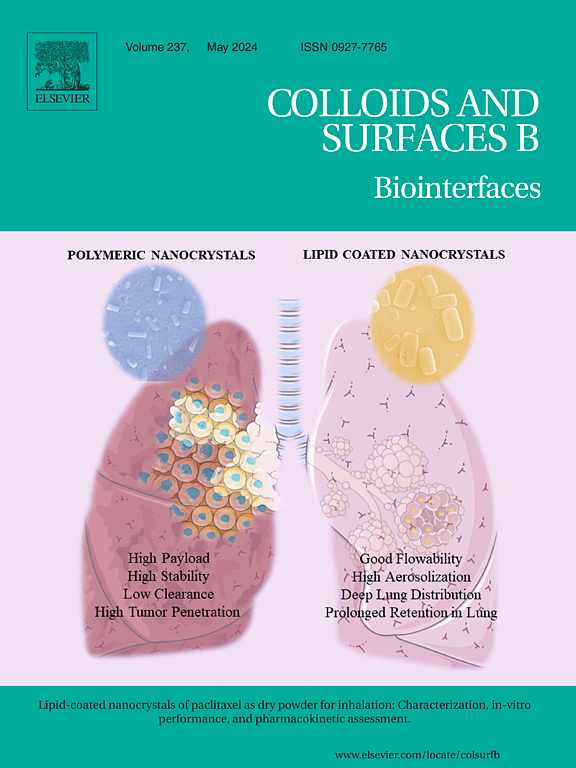Bimetallic nanozyme-mediated dual ferroptosis/cuproptosis synergy potentiates immunotherapy in bladder cancer
IF 5.4
2区 医学
Q1 BIOPHYSICS
引用次数: 0
Abstract
Immunotherapy for bladder cancer remains limited by immunosuppressive tumor microenvironment (TME) and low immunogenicity. Here, we developed a TME-responsive bimetallic porous nanozyme, Fe/Cu-HPC@GOx/PEG, to synergistically induce dual ferroptosis/cuproptosis and amplify antitumor immunity. The nanozyme integrates Fe-Cu bimetal catalytic centers within a hierarchical porous carbon framework, enabling glucose oxidase (GOx)-triggered H₂O₂ generation and subsequent Fenton/Fenton-like reactions. In vitro studies demonstrated that the nanozyme effectively depleted glutathione, inactivated GPX4, and accumulated lipid peroxides to drive ferroptosis. Concurrently, hypoxia alleviation via O₂ generation suppressed HIF-1α-mediated glycolysis, blocked ATP7B-dependent Cu⁺ efflux, and triggered DLAT lipoylation, leading to cuproptosis. Mitochondrial dysfunction from dual cell death pathways synergistically enhanced oxidative stress and immunogenic cell death (ICD), evidenced by calreticulin exposure, HMGB1/ATP release, and dendritic cells maturation. In vivo, Fe/Cu-HPC@GOx/PEG significantly suppressed tumor growth and remodeled the TME, with increased CD8⁺ T cell infiltration and elevated pro-inflammatory cytokines. Systemic toxicity evaluation confirmed biocompatibility, showing no organ damage or biochemical abnormalities. This work presents a paradigm-shifting strategy that leverages metal ion-mediated dual death pathways to overcome immunotherapy resistance, offering a clinically translatable nanoplatform for precision oncology.
双金属纳米酶介导的双铁下垂/铜下垂协同作用增强了膀胱癌的免疫治疗
膀胱癌的免疫治疗仍然受到免疫抑制肿瘤微环境(TME)和低免疫原性的限制。在这里,我们开发了一种响应tme的双金属多孔纳米酶Fe/Cu-HPC@GOx/PEG,以协同诱导双铁下垂/铜下垂并增强抗肿瘤免疫。纳米酶将Fe-Cu双金属催化中心集成在分层多孔碳框架内,使葡萄糖氧化酶(GOx)触发的H₂O₂生成和随后的Fenton/Fenton样反应成为可能。体外研究表明,纳米酶有效地消耗谷胱甘肽,使GPX4失活,并积累脂质过氧化物来驱动铁死亡。同时,通过O₂生成缓解缺氧抑制hif -1α-介导的糖酵解,阻断atp7b依赖的Cu +外排,触发DLAT脂酰化,导致铜还原。双细胞死亡途径的线粒体功能障碍协同增强氧化应激和免疫原性细胞死亡(ICD),钙网蛋白暴露、HMGB1/ATP释放和树突状细胞成熟证明了这一点。在体内,Fe/Cu-HPC@GOx/PEG显著抑制肿瘤生长并重塑TME, CD8 + T细胞浸润增加,促炎细胞因子升高。全身毒性评价证实生物相容性,未见器官损伤或生化异常。这项工作提出了一种范式转换策略,利用金属离子介导的双死亡途径来克服免疫治疗耐药性,为精确肿瘤学提供了临床可翻译的纳米平台。
本文章由计算机程序翻译,如有差异,请以英文原文为准。
求助全文
约1分钟内获得全文
求助全文
来源期刊

Colloids and Surfaces B: Biointerfaces
生物-材料科学:生物材料
CiteScore
11.10
自引率
3.40%
发文量
730
审稿时长
42 days
期刊介绍:
Colloids and Surfaces B: Biointerfaces is an international journal devoted to fundamental and applied research on colloid and interfacial phenomena in relation to systems of biological origin, having particular relevance to the medical, pharmaceutical, biotechnological, food and cosmetic fields.
Submissions that: (1) deal solely with biological phenomena and do not describe the physico-chemical or colloid-chemical background and/or mechanism of the phenomena, and (2) deal solely with colloid/interfacial phenomena and do not have appropriate biological content or relevance, are outside the scope of the journal and will not be considered for publication.
The journal publishes regular research papers, reviews, short communications and invited perspective articles, called BioInterface Perspectives. The BioInterface Perspective provide researchers the opportunity to review their own work, as well as provide insight into the work of others that inspired and influenced the author. Regular articles should have a maximum total length of 6,000 words. In addition, a (combined) maximum of 8 normal-sized figures and/or tables is allowed (so for instance 3 tables and 5 figures). For multiple-panel figures each set of two panels equates to one figure. Short communications should not exceed half of the above. It is required to give on the article cover page a short statistical summary of the article listing the total number of words and tables/figures.
 求助内容:
求助内容: 应助结果提醒方式:
应助结果提醒方式:


